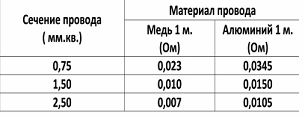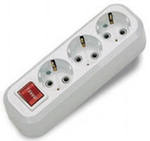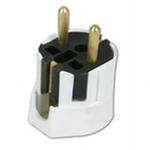Categories: Featured Articles » Sharing experience
Number of views: 113005
Comments on the article: 6
How to calculate cable for extension cable
 In every modern house - apartment, of course, there is an extensive electric network. Each room has one or two outlets. But, as on purpose, they are usually located in the wrong place. Or the number of electrical appliances that must be turned on exceeds the number of outlets. Or you must turn on a portable appliance, such as an electric heater.
In every modern house - apartment, of course, there is an extensive electric network. Each room has one or two outlets. But, as on purpose, they are usually located in the wrong place. Or the number of electrical appliances that must be turned on exceeds the number of outlets. Or you must turn on a portable appliance, such as an electric heater.
These electrical appliances sometimes consume significant electrical power. Then portable extension sockets come to our aid. Cable for such a portable outlet, it is necessarily selected in double rubber insulation (the wires themselves are insulated and additionally placed in an external insulating sheath).
Best when the wires in the cable are stranded, flexible. The diameter or cross-section of the wires must correspond to the permissible electrical load.
What should be wire cross section cable? From school physics we know Ohm's law. It says that each conductor has a certain electrical resistance to the electric current flowing through it.
The magnitude of the electrical resistance depends on the material of the conductor (here wires), its length and cross section. The thicker the wire, the lower its electrical resistance, the lower the voltage drop across it and the less the loss of power on its heating.
The cables that are most suitable for the manufacture of a portable extension socket have a section: 0.75; 1.5; 2.5 mm2
We will analyze several manufacturing options for carrying cables:
- different cross sections: 0.75; 1.5; 2.5 mm2 ;
- veins are made of different materials (copper and aluminum);
- different lengths of the extension cord 5 and 10 meters.
As a load, we use an electric heater with a power of P = 2.2 kilowatts or 2200 watts. Its current consumption will be: I = P / U = 2200 watts / 220 volts = 10 amperes.
In the reference book on electrical engineering, we take the values of electrical resistances of 1 meter of copper and aluminum wires for different cross sections and bring them to a table.

We will calculate the power loss in the cable that goes to heat the wire, that is, irretrievably lost.
We carry out the calculation for a cable with copper conductors with a length of L = 5 meters and a cross section of 0.75 mm.kv. From the table we see that 1 meter of copper wire with a cross section of 0.75 mm.kv. has a resistance of R1 = 0.023 ohms.
The length of the wire in the cable (there and back): L = 2 x 5 m = 10 meters. The resistance of the two wires is: R = 2 x L x R1 = 2 x 5 x 0.023 = 0.23 Ohm.
With a current of I = 10 amperes, the voltage drop in the cable with a cross section of 0.75 mm.sq. will be: U = I x R = 10 x 0.23 = 2.3 volts.
The power allocated for heating the cable will be P = U x I = 2.3 x 10 = 23 watts.
In a cable 10 meters long of the same section, the power loss will be twice as much - 46 watts.
The loss of electrical power leaving the heating wire will be about 2% of the power consumed by the network. The heating of the wire will be negligible, but it is better that there is no heating at all.
Loss of electrical power for a cable with aluminum conductors of the same cross-section 0.75 mm.kv. will be:
- for a cable 5 meters long - 69 watts;
- for a cable 10 meters long - 138 watts.
These are already quite significant power losses. The cable will become very hot and a fire may occur in the insulation.
Calculation data for copper and aluminum cables for different sections and lengths are collected in a table.
Here:
- S - wire section in mm.kv .;
- R1 - resistance of 1 meter of wire in Ohms;
- R - cable resistance in ohms;
- U - voltage drop in the cable in Volts;
- P - power loss in the cable in watts and in percent.

Analysis of the calculations shows that it is necessary to take seriously the choice of cable cross-section and the material of which the wires are made.
Conclusions:
- A cable with copper conductors, in comparison with a cable with aluminum conductors, with the same length and cross-section, has a greater margin of reliability and less power loss for heating.
- A cable with copper conductors is most preferred in use.
- The longer the cable, the greater the power loss R. To compensate for the power loss, you can increase the cross-section of the wire in the cable.
- The cable must be flexible, have good external insulation, preferably rubber.
- The cable wire must be stranded.
Compliance with the necessary electrical parameters of the cable and its mechanical strength is the key to the reliable operation of the extension cord.
My calculation - the analysis is only advisory in nature. Someone will say: here I have a carrying out of an aluminum wire, it has been working for a long time, it gets a little warm and nothing happened. Until nothing happened !!
It is up to everyone to decide which is better: reliability and safety or ... ..
And further! The most vulnerable point of the electrical circuit is the junction of the wires, transition resistance between them.
Now the transition of household electrical networks to the use of Euro-plugs and Euro-outlets is gradually happening. A simple electric plug has a 4 mm pin diameter. The Euro plug has a 5 mm pin diameter. And it is designed for more current than a simple plug.
The larger the diameter of the plug pins - the larger the contact area at the junction of the plug and the socket - the lower the transition resistance between them - the less the heating of the junction. Use Euro plugs and Euro sockets! Here is such an advertisement.


And that's not all! If you have a cable designed to connect a 3-phase load, you're in luck. Such a cable has 4 wires - 3 for connecting the phases and 1 for connecting the neutral wire.
It is possible, and even necessary, to form two wires from them, twisting in pairs. Get a pair of double cross-section wires. Just be careful that it doesn’t happen that at one end of the cable some wires are twisted, and at the other end. A short circuit may occur. Now everything seems.
Victor Egel
We recommend reading: How to choose the right cable cross section for wiring
See also at i.electricianexp.com
:
